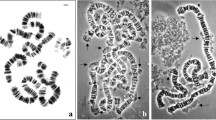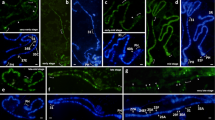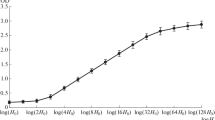Abstract
Salivary-gland nuclei ofDrosophila hydei were pulse-labeledin vitro with3H-thymidine and studied autoradiographically in squash preparations. The distribution of radioactive label over the length of the polytene chromosomes was discontinuous in most of the labeled nuclei; in some nuclei the pattern of incorporation was continuous. Comparison of the various labeling patterns of homologous chromosome regions in different nuclei showed that specific replicating units are replicated in a specific order. By combining autoradiography with cytophotometry of Feulgen-stained chromosomes, it was possible to correlate thymidine labeling of specific bands with their DNA content. The resulting data indicate that during the S-period many or perhaps all of the replicating units in a salivary-gland nucleus start DNA synthesis simultaneously but complete it at different times. Furthermore, the data support the hypothesis that the chromomere is a unit of replication or replicon. The DNA content of haploid chromomeres was found to be about 5×10-4 pg for the largest bands inDrosophila hydei. From the results of H3-thymidine autoradiography and Feulgen-cytophotometry on neuroblast and anlage nuclei it was concluded that during growth of the polytenic nucleus heterochromatin is for the most part excluded from duplication. The results of DNA measurements in interbands of polytene chromosomes do not agree with a multistrand structure for the haploid chromatid. A chromosome model is proposed which is in accordance with the reported results and with current views concerning the replicative organization of chromosomes.
Similar content being viewed by others
References
Alfert, M. (1954). Composition and structure of giant chromosomes.Intern. Rev. Cytol. 3: 131–176.
Barigozei, C., S. Dolfini, M. Fraccaro, G. R. Raimondi & L. Tiepolo (1966), In vitro study of the DNA replication patterns of somatic chromosomes ofDrosophila melanogaster.Exptl. Cell Research 43: 231–234.
Becker, H. J. (1959). Die Puffs der Speicheldrüsenchromosomen vonDrosophila melanogaster. I. Mitteilung: Beobachtungen zum Verhalten des Puffmusters im Normalstamm und bei zwei Mutanton,giant undlethalgiant-larvae.Chromosoma 10: 654–678.
Beermann, W. (1965). Operative Gliederung der Chromosomen.Naturwiss. 52: 365–375.
Beermann, W. & C. Pelling (1965). H3-Thymidin-Markierung einzelner Chromatiden in Riesenchromosomen.Chromosoma 16: 1–21.
Belling, J. (1928). The ultimate chromomeres ofLilium andAloe with regard to the numbers of genes.Univ. Cal. Publ. Bot. 14: 307–318.
Berendes, H. D. (1963). The salivary gland chromosomes ofDrosophila hydei Sturtevant.Chromosoma 14: 195–206.
Berendes, H. D. (1966). Differential replication of male and female X-Chromosomes inDrosophila.Chromosoma 20: 32–43.
Berendes, H. D. & H. G. Kevl (1967). Distribution of DNA in heterochromatin and euchromatin of polytene nuclei ofDrosophila hydei.Genetics 57: 1–13.
Bianchi, N. O. & M. S. A. de Bianchi (1965). DNA replication sequence of human chromosomes in blood cultures.Chromosoma 17: 273–290.
Bloch, D. P., R. A. Macquigg, S. D. Brack & J.-R. Wu (1967). The syntheses of deoxyribonucleic acid and histone in the onion root meristem.J. Cell Biol. 33: 451–467.
Bonhoeffer, F. & A. Gierer (1963). On the growth mechanism of the bacterial chromosome.J. Mol. Biol. 7: 534–540.
Braun, R., C. Mittermayer & H. P. Rusch (1965). Sequential temporal replication of DNA inPhysarum polycephalum.Proc. Natl. Acad. Sci. 53: 924–931.
Cairns, J. (1963a). The bacterial chromosome and its manner of replication as seen by autoradiography.J. Mol. Biol. 6: 208–213.
Cairns, J. (1963b). The chromosome ofEscherichia coli.Cold Spring Harbor Symp. Quant. Biol. 28: 43–46.
Cairns, J. (1966). Autoradiography of HeLa Cell DNA.J. Mol. Biol. 15: 372–373.
Callan, H. G. (1963). The nature of lampbrush chromosomes.Int. Rev. Cytol. 15: 1–34.
Callan, H. G. (1966). Chromosomes and nucleoli of the Axoloti,Ambystoma mexicanum.J. Cell Sci. 1: 85–108.
Chang, T. H., V. Defendi & P. S. Moorhead (1965), DNA replication patterns in cultured female rat fibroblasts.Can. J. Genet. Cytol. 7: 571–582.
Cummins, J. E. & H. P. Rusch (1966). Limited DNA synthesis in the absence of protein synthesis inPhysarum polycephalum.J. Cell Biol. 31: 577–583.
Danieli, G. A. & E. Rodino (1967). Larval moulting cycle and DNA synthesis inDrosophila hydei salivary glands.Nature 213: 424–425.
Darlington, C. D. & A. Haque (1966). Organization of DNA synthesis in rye chromosomes. In: “Chromosomes Today” (C. D. Darlington & K. R. Lewis eds.), p. 102–107. Oliver and Boyd, Edinburgh.
DuPraw, E. J. (1965). Macromolecular organization of nuclei and chromosomes: A folded fibre model based on whole mount electron microscopy.Nature 206: 338–343.
DuPraw, E. J. & P. M. M. Rae (1966). Polytenechromosome structure in relation to the ”folded fibre“ concept.Nature 312: 598–600.
Edström, J. E. (1964). Chromosomal RNA and other nuclear RNA fractions. In: “The Role of Chromosomes in Development” (M. Locke ed.), p. 137–152. Academic Press, New York.
Evans, H. J. (1964). Uptake of3H-thymidine and patterns of DNA replication in nuclei and chromosomes ofVicia taba.Exptl. Cell Research 35: 381–393.
Evans, H. J. & J. R. K. Savage (1963). The relation between DNA synthesis and chromosome structure as resolved by X-ray damage.J. Cell Biol. 18: 525–540.
Fico, A. & C. Pavan (1957). Autoradiography of polytene chromosomes ofRhynchosciara angelae at different stages of larval development.Nature 180: 983–984.
Gabrusewycz-Garcia, N. (1964). Cytological and autoradiographic studies inSciara coprophila salivary gland chromosomes.Chromosoma 15: 312–344.
Gay, H. (1963). Chromosomal structure and function.Carnegic Inst. Wash. Yearbook 62: 501–510.
Gay, H. (1964). Chromosomal structure and function,Carnegie Inst. Wash. Yearbook 63: 605–614.
Goodman, R. M., S. Bader & H. V. Crouse (1963). The incorporation of thymidine-H3 and uridine-H3 in salivary gland nuclei ofSciara examined by light and electron microscopy. J. Cell Biol.19: 28A.
Hardin, J. A., G. E. Einem & D. T. Lindsav (1967). Simultaneous synthesis of histone and DNA in synchronously dividingTetrahymena pyriformis.J. Cell Biol. 32: 709–717.
Hess, O. (1966). Funktionelle und strukturelle Organisation der Lampenbürsten-Chromosomen. In: “Problemo der biologischen Reduplikation” (P. Sitte ed.), p. 29–54. Springer-Verlag, Berlin.
Hotta, Y. & A. Bassel (1965). Molecular size and circularity of DNA in cells of mammals and higher plants.Proc. Natl. Acad. Sci. 53: 356–362.
Huberman, J. A. & A. D. Riggs (1966). Autoradiography of chromosomal DNA fibers from Chinese hamater cells.Proc. Natl. Acad. Sci. 55: 599–606.
Jacob, F. & S. Brenner (1963). Sur la régulation de la synthèse du DNA chez les bactéries: l'hypothèse du réplicon.Comptes rendus Acad. Sci. 256: 298–300.
Keyl, H. G. (1964). Verdopplung des DNS-Gehalts kleiner Chromosomenabschnitte als Faktor der Evolution.Naturwiss. 51: 46–47.
Keyl, H. G. (1965). Duplikationen von Untereinheiten der chromosomalen DNS während der Evolution vonChironomus thummi.Chromosoma 17: 139–180.
Keyl, H. G. (1966). Lokale DNS-Replikationen in Riesenchromosomen. In: “Probleme der biologischen Reduplikation” (P. Sitte ed.). p. 55–69. Springer-Verlag, Berlin.
Keyl, H. G. & C. Pelling (1968). Differentielle DNS-Replikation in den Speicheldrüsen-Chromosomen vonChironomus thummi.Chromosoma 14: 347–359.
Kikuchi, Y. & A. A. Sandberg (1964). Chronology and pattern of human chromosome replication. I. Blood leucocytes of normal subjects.J. Natl. Cancer Inst. 32: 1109–1143.
Lark, K. G. (1963). Cellular control of DNA biosynthesis. In: “Molecular Genetics” (J. H. Taylor ed.), p. 153–206. Academic Press, New York.
Lark, K. G., T. Rerko, & E. Hoffman (1963). The effect of amino acid deprivation on subsequent deoxyribonucleic acid replication.Biochim. Biophys. Acta 76: 9–24.
Lima-de-Faria, A. (1961). Initiation of DNA synthesis at specific segments in the meiotic chromosomes ofMelanoplus.Hereditas 47: 674–694.
Littlefield, J. W. & P. S. Jacobs (1965). The relation between DNA and protein synthesis in mouse fibroblasts.Biochim. Biophys. Acta 108: 652–658.
Miller, O. L. (1964). Extrachromosomal nucleolar DNA in Amphibian oocytes.J. Cell Biol. 23: 60A.
Moorhead, P. S. & V. Defendi (1963). Asynchrony of DNA synthesis in chromosomes of human diploid cells.J. Cell Biol. 16: 202–209.
Mueller, G. C. & K. Kajiwara (1966a). Early- and late-replicating deoxyribonucleic acid complexes in HeLa nuclei.Biochim. Biophys. Acta 114: 108–115.
Wueller, G. C. & K. Kajiwara (1966b). Actinomycin D and p-fluorophenylalanine, inhibitors of nuclear replication in HeLa cells.Biochim. Biophys. Acta 119: 557–565.
Nagata, T. (1963). The molecular synchrony and sequential replication of DNA inEscherichia coli.Proc. Natl. Acad. Sci. 49: 551–559.
Painter, R. B., D. A. Jermany & R. E. Rasmussen (1966). A method to determine the number of DNA replicating units in cultured mammalian cells.J. Mol. Biol. 17: 47–56.
Painter, R. B. & R. E. Rasmussen (1964). Organization of the deoxyribonucleic acid replicating system in mammalian cells as revealed by the use of X-radiation and bromuracil deoxyriboside.Nature 201: 162–165.
Pavan, C. (1965). Synthesis. In: “Genetics Today” (S. J. Geerts ed.). Proc. XIth Int. Congr. Genetics, vol. 2, p. 335–342. Pergamon Press, Oxford.
Pelling, C. (1966). A replicative and synthetic chromosomal unit-the modern concept of the chromomere.Proc. Royal Soc. 164-B, 279–289.
Petersen, A. J. (1964). DNA synthesis and chromosomal asynchrony.J. Cell Biol. 23: 651–654.
Plaut, W. (1963). On the replicative organization of DNA in the polytene chromosome ofDrosophila melanogaster.J. Mol. Biol. 7: 632–635.
Plaut, W., & D. Nash (1964). Localized DNA synthesis in polytene chromosomes and its implications. In: “The Role of Chromosomes in Development” (M. Locke ed.), p. 113–135. Academic Press, New York.
Plaut, W., D. Nash & T. Fanning (1966). Ordered replication of DNA in polytene chromosomes ofDrosophila melanogaster.J. Mol. Biol. 16: 85–93.
Ploem, J. S. (1967). The use of a vertical illuminator with interchangeable dichroic mirrors for fluorescence microscopy with incident light.Z. wiss. Mikroskop. 68: 129–137.
Prescott, D. M. (1966). The syntheses of total macronuclear protein, histone and DNA during the cell cycle inEuplotes eurystomus.J. Cell Biol. 31: 1–9.
Ritossa, F. M. & S. Spiegelman (1965). Localization of DNA complementary to ribosomal RNA in the nucleolus organizer region ofDrosophila melanogaster.Proc. Natl. Acad. Sci. 53: 737–745.
Rudkin, G. T. (1965a). The structure and function of heterochromatin. In: “Genetics Today” (S. J. Geerts ed.), Proc. XIth Int. Congr. Genetics, vol. 2, p. 359–374. Pergamon Press, Oxford.
Rudkin, G. T. (1965b). Nonreplicating DNA in giant chromosomes.Genetics 52: 470.
Rudkin, G. T. (1965c). The relative mutabilities of DNA in regions of the X chromosome ofDrosophila melanogaster.Genetics 52: 665–681.
Sasaki, M. S. & A. Norman (1966). DNA fibres from human lymphocyte nuclei.Exptl. Cell Research 44: 642–645.
Sonnenblick, B. P. (1950). The early embryology ofDrosophila melanogaster. In: “The Biology of Drosophila” (M. Demerec, ed.), p. 62–165. Wiley, New York.
Spalding, J., K. Kajiwara & G. C. Mueller (1966). The metabolism of basic proteins in Hela cell nuclei.Proc. Natl. Acad. Sci 56: 1535–1542.
Steffensen, D. M. (1963). Evidence for the apparent absence of DNA in the interbands ofDrosophila salivary chromosomes.Genetics 48: 1289–1301.
Swift, H. (1955). Cytochemical techniques for nucleic acids. In: “The Nucleic Acids” (E. Chargaff and J. N. Davidson eds.), vol. 2, p. 51–92. Academic Press, New York.
Swift, H. (1964). The histones of polytene chromosomes. In: “The Nucleohistones” (J. Bonner and P. Ts'o eds.), p. 169–183. Holden-Day, San Francisco.
Taylor, E. W. (1965). Control of DNA synthesis in mammalian cells in culture.Exptl. Cell Research 40: 316–332.
Taylor, J. H. (1958). The mode of chromosome duplication inCrepis capillaris.Exptl. Cell Research 40: 350–357.
Taylor, J. H. (1960). Asychronous duplication of chromosomes in cultured cells of Chinese hamster.J. Biophys. Biochem. Cytol. 7: 455–464.
Taylor, J. H. (1964). Regulation of DNA replication and variegation-type position effects. In: “Cytogenetics of Cells in Culture” (R. J. C. Harris ed.), p. 175–190. Academic Press, New York.
Taylor, J. H. & K. C. Subbaiah (1966). DNA replication in cell cultures of Chinese hamster.J. Cell Biol. 31: 117A.
Tonkelaar, E. M. den & P. van Duijn (1964). Photographic colorimetry as a quantitative cytochemical method, I. Principles and practice of the method.Histochemie 4: 1–9.
Tulchin, N., G. M. Matevko & M. J. Kopac (1967).Drosophila salivary glands in vitro.J. Cell Biol. 34: 891–897.
Whitehouse, H. L. K. (1967). A cycloid model for the chromosome.J. Cell Sci. 2: 9–22.
Wimber, D. E. (1961). Asynchronous replication of deoxyribonucleic acid in root tip chromosomes ofTradescantia paludosa.Expt. Cell Research 23: 402–407.
Wolff, S. & H. E. Luippold (1964). Chromosome splitting as revealed by combined X-ray and labeling experiments.Exptl. Cell Research 34: 548–556.
Wolstenholme, D. R. (1965). The distribution of DNA and RNA in salivary gland chromosomes ofChironomus tentans as revealed by fluorescence microscopy.Chromosoma 17: 219–229.
Wolstenholme, D. R. (1966). Direct evidence for the presence of DNA in interbands ofDrosophila salivary gland chromosomes.Genetics 53: 357–360.
Yoshikawa, H. & N. Sueoka (1963). Sequential replication ofBacillus subtilis chromosome. I. Comparison of marker frequencies in exponential and stationary growth phases.Proc. Natl. Acad. Sci. 49: 559–566.
Author information
Authors and Affiliations
Rights and permissions
About this article
Cite this article
Mulder, M.P., van Duijn, P. & Gloor, H.J. The replicative organization of DNA in polytene chromosomes ofDrosophila hydei . Genetica 39, 385–428 (1968). https://doi.org/10.1007/BF02324479
Received:
Issue Date:
DOI: https://doi.org/10.1007/BF02324479




